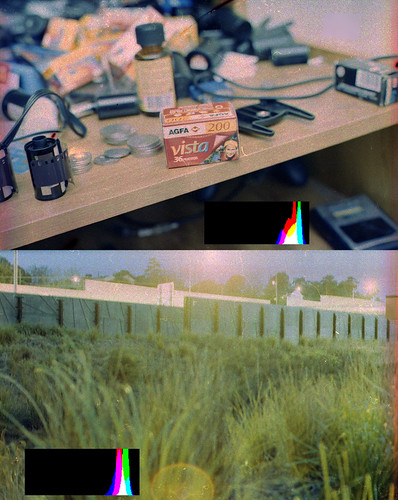Top is CuSO4, bottom is Flexicolor.
2min 45 sec in Flexicolor C-41 (38c), EI 50 (was intending +3 EI and N-2 dev.. not sure that worked out given the density)
This test though does prove Copper Sulphate Bleach WORKS, and the colour seems fine.
The density may seem similar overall, but each individual channel on the CuSO4 bleach is broader, though its a different image of course.
Anyway, density on both is so close to the end of the scanner range, that is normally clipped by 'max' levels, becomes hard to correct colour.
In any case, film is fogged, too much exposure also I guess for 2min 45sec.
But if the CuSO4 didn't work as a bleach, then there would also be a silver neg image on the film (which you could see by eye if there was), AND the density would be even greater, when max density is about the same as Flexicolor, differences due to exposure.
Other indications CuSO4 works: Back of film turns green/blue in bleach like its supposed, and you can see the image on the back of the film before fixing like it's supposed to as well.
Test needs to be re-done with fresh film, normal exposure and development.
But a big tick so far for CuSO4.
Bleach recipe used (I only mixed up 100mL in a beaker for a single frame):
100g/litre Copper Sulphate
100g/litre NaCl (I used table salt, whic his sea salt + anti caking agent since thats all I had - is fine).
You're supposed to filter or decant it as well, but I didn't.
According to literature I have, the shelf life is supposed to be 12 months or more (copper sulphate and salt aint going nowhere!), and the capacity is supposed to be 5 x 36exp 35mm rolls per litre (I'm sure it'd be more like other bleaches).
Bleaching time is alleged to be 6-7 min for film (C-41 and E-6) at 24 degrees celsius (I walked away and left both for 17 minutes as I forgot about them).
For paper (RA-4) its alleged 3-4 min at 24 celsius, and allegedly can do 30 8x10 prints a litre.





